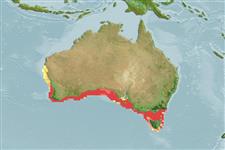Environment: milieu / climate zone / depth range / distribution range
экология
морской демерсальный; пределы глубины ? - 120 m (Ref. 9563). Temperate
Eastern Indian Ocean: Australia (southern Western Australia to Victoria and Tasmania).
Size / Вес / Возраст
Maturity: Lm ? range ? - ? cm
Max length : 51.0 cm TL самец/пол неопределен; (Ref. 9563)
Occurs on offshore reefs. The black horse-shoe marking along flanks is diagnostic for this species (Ref. 9563).
Life cycle and mating behavior
половая зрелость | размножение | нерест | икра | Fecundity | личинки
May, J.L. and J.G.H. Maxwell, 1986. Trawl fish from temperate waters of Australia. CSIRO Division of Fisheries Research, Tasmania. 492 p. (Ref. 9563)
Статус Красного Списка МСОП (Ref. 130435: Version 2024-1)
Угроза для людей
Harmless
Использование человеком
дополнительная информация
инструменты
Специальные отчеты
Скачать в формате XML
ресурсы в Интернет
Estimates based on models
Preferred temperature (Ref.
123201): 14.7 - 20.1, mean 17 °C (based on 228 cells).
Phylogenetic diversity index (Ref.
82804): PD
50 = 0.5039 [Uniqueness, from 0.5 = low to 2.0 = high].
Bayesian length-weight: a=0.01995 (0.00956 - 0.04164), b=2.93 (2.76 - 3.10), in cm total length, based on LWR estimates for this (Sub)family-body shape (Ref.
93245).
Trophic level (Ref.
69278): 2.8 ±0.4 se; based on size and trophs of closest relatives
устойчивость к внешним воздействиям (Ref.
120179): средний (среднего размера), минимальное время удвоения популяции 1.4-4.4 года (Preliminary K or Fecundity.).
Fishing Vulnerability (Ref.
59153): Moderate vulnerability (40 of 100).
Nutrients (Ref.
124155): Calcium = 27.8 [11.0, 70.2] mg/100g; Iron = 0.367 [0.152, 0.896] mg/100g; Protein = 17.6 [15.4, 19.9] %; Omega3 = 0.431 [0.181, 0.946] g/100g; Selenium = 15.9 [7.6, 36.8] μg/100g; VitaminA = 8.23 [2.14, 32.23] μg/100g; Zinc = 0.499 [0.338, 0.802] mg/100g (wet weight);
